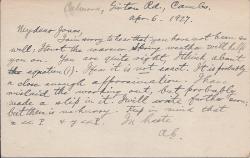
Four items, including blueprint and papers, regarding the 'Campbell Capacitance Bridge' of Albert Campbell of the British National Physical Laboratory, Teddington. With Autograph Postcard Signed ('A.C.') from Campbell to Prof. R. H. Jones.
All items with texts clear and complete. The collection fair, on aged paper. ITEM ONE: Postcard, 6 April 1927; Culmora, Girton Rd, Cambs. Nine lines. The equation is not exact, but is probably 'a close enough approximation'. He has 'mislaid the working out, but probably made a slip in it.' ITEM TWO: Mimeographed typescript (4to, 3 pp), headed 'Campbell Capacitance Bridge'. On three letterheads of the Cambridge Instrument Company. Begins 'This Capacitance Bridge has been designed by Mr. Albert Campbell to provide a quick and easy method of measuring capacitance and inductance with an accuracy of approximately 1%.' At end: 'Attached Blue Print. D. 544. [see next].' ITEM THREE: Blueprint, 'Dr. No. D. 544'. 4to, 1 p. Stamped 'Camb[ridge]: Inst[rument]: Co. | Muswell Hill | 29 Dec 1926'. ITEM FOUR: Two copies (one a proof?) of offprint paper from the Proceedings of the Physical Society, entitled 'A Capacitance Bridge of Wide Range and a new Inductometer'. Received on 16 November 1926. One copy with brief manuscript notes at foot of first page, the other with each page laid down on a separate leaf of a folder. Campbell's obituary, The Times, 9 February 1954, describes as perhaps the most important of his contributions to physics 'the design and installation of the primary standard of mutual inductance and the development of subsidiary apparatus and methods which made this the ultimate standard of reference for all the alternating current measurements in his department'.


